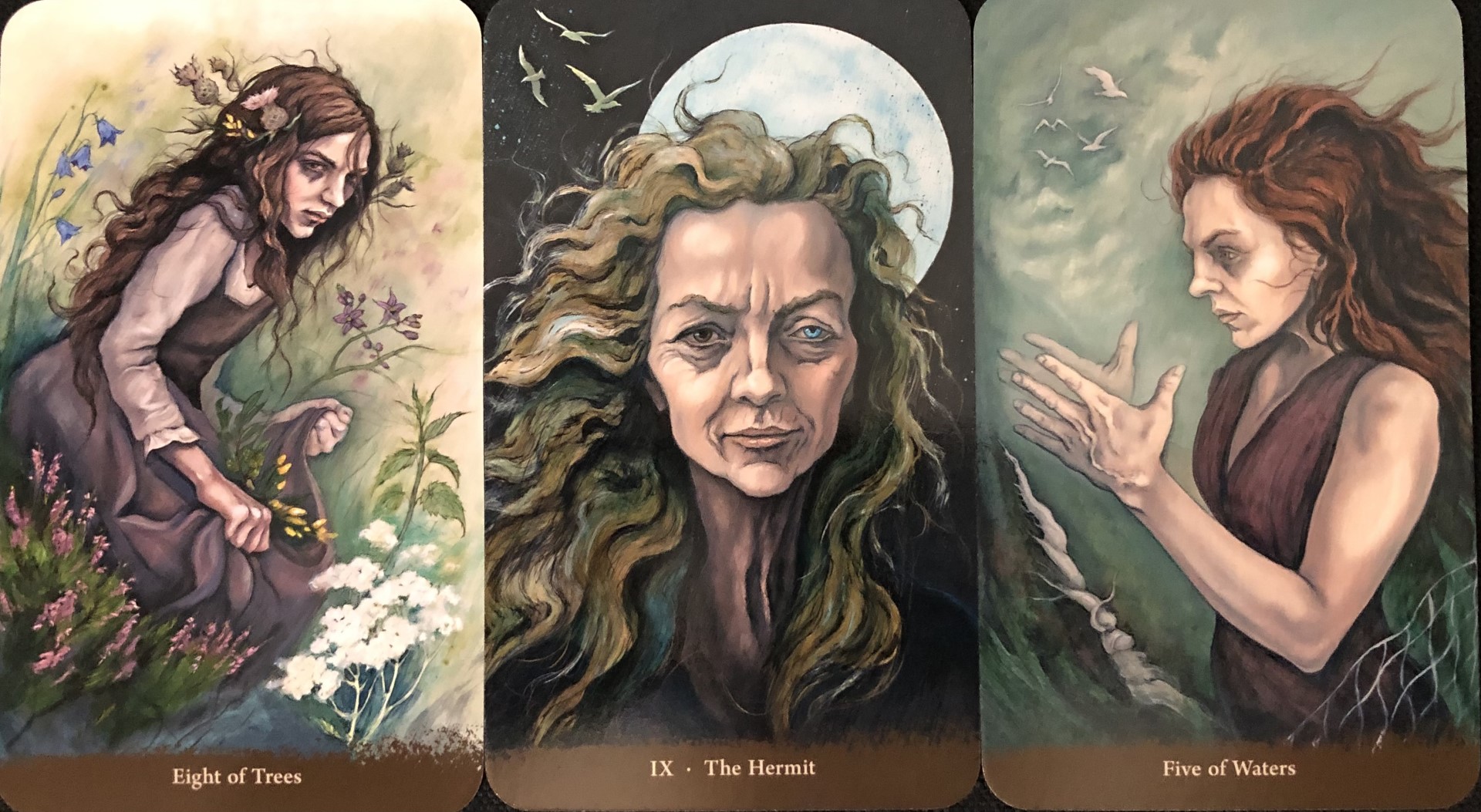Review: Witch Sister Tarot: Taking Flight With Your Witch Sisters by Julia Jeffrey

by
Charlie |
|

Review by Beth Allen
Witch Sister Tarot: Taking Flight With Your Witch Sisters by Julia Jeffrey is a beautiful deck, and moreover, it’s a powerful one.
After working with the cards I’ve developed an immense respect for them. I approach this deck like no other in my collection — with a reverence and almost devoutness that I feel the art and stories command.
When you use this deck, and its incredible guidebook, you’re not only getting tarot, you’re also gaining some understanding of Celtic lore, specifically Scottish magic.
The guidebook provides a treasure trove of tales that have circled around the storied witch/goddesses for centuries. From shape-shifters like the Queen of Elphame and The Morrigan, to the cauldron of Ceridwen, to the Well of Youth and the Cailleach, or the stormy powers of Gormshuil, the spirit and memory of those times stoke the fires of our imaginations like juniper rituals.
Hares, stags, rowan, and thistle, the symbols and meanings in these cards are infused with olde magick, protection, and as the full title of the deck suggests, flight.
The cards’ messages can be passionate or playful, straightforward or nurturing depending on the query, the context, and the Witch Sister who swoops in to assist.
Never dull, the readings may strike like an Elf-Stroke, be stern yet fair like The Great Mother, or soothe and calm like Chliodhna, the Witch of Waters and daughter of the Celtic god of the sea.
Whether tempestuous or mild, I‘ve found the readings to be spot on.
Steeped in Scottish history and the figures who make up the witch/goddess pantheon, this deck offers up a heaping plate of knowledge with a tempting invitation to feast further in your own studies.
Jeffrey has done a marvelous job of weaving the tales consistently throughout the 78 cards, thereby creating a cohesive tarot deck.
To accomplish this formidable task as completely and intelligently as she does, the deck departs from the original RWS meanings often, and in some cases drastically.
Throughout the deck the meanings exemplify a pagan perspective, rather than a colonial one.
The Majors, Minors, and Courts all contain some cards that diverge from the traditional RWS, while Jeffrey’s guidebook provides a summary of each “new” character with a bit of backstory.
After The Fool and The Magician, for example, we have Nicneven for The High Priestess. We learn that her domain is shadow and moonlight and that she, like Hecate in Greek lore, is mysterious, secretive, and connected to the night and to the realm of the dead.
The Empress is The Queen of Elphame, who like Mother Nature, creates beautiful things but can be “deeply unpredictable.”
The suits in the Minor Arcana are nature-based and elemental: Trees/Fire is Wands, Waters/Water is Cups, Skies/Air is Swords, and Stones/Earth is Pentacles.
These changes conform to the important role nature and the elements played in the everyday lives of the Celts.
The Minor Arcana is an interesting mix of cards: some vary a great deal from traditional RWS meanings, some stray off path just a little, others follow the RWS meanings with only a slightly different perspective, which mostly adds depth and layers.The Seven of Waters has a completely different meaning from the traditional Seven of Cups, for example.
The Seven of Cups is about choice, having options, or feeling overwhelmed by these choices and options. The Seven of Waters begins with a fascinating description of a magical cormorant referred to as the Cailleach Dhubh, or Black Hag, and its link to the goddess Cailleach Bheara.
As described in the guidebook, “With her wild sisters she is free to soar through the storm, or plunge headlong beneath the waves, unconstrained by earthly ties.” Her cowrie shells symbolize abundance, the card itself represents overcoming challenges and forming community with like-minded companions to empower ourselves and take flight.
An example of a Minor that strays from the original RWS meaning but gets the reader to the same destination is the Six of Trees (Six of Wands). Citing the Rye-Mother, this dark spirit presents herself as a beautiful young woman who preys on men working the fields at harvest. The Six of Trees represents the heat of the August harvest festival of Lughnasadh, where abundance and beauty are readily found. It reminds us to acknowledge the sacrifices we’ve made in order to manifest this abundance and to celebrate that.
Finally in the Nine of Skies (Nine of Swords) we have an example of a Minor that fundamentally follows traditional RWS meaning while staying true to the deck’s theme. Relating the card to the tale of Blodeuwedd, the card’s message is not to allow ourselves to feel robbed of our power, that we have choices and we can find solutions without feeling despair or a loss of control.
The Court titles have two changes: the Maid (Page) and the Witch (Knight), followed by the Queen and King of each suit.
Jeffrey lives in Scotland where she also illustrated The Tarot of the Hidden Realm. Her research into Celtic magic, especially that of her homeland, is impressive. Both illustrator and writer of this deck, Jeffrey‘s work is a testament to the historical importance of the witch/goddess as both archetype and ancestor.
Published by Llewellyn, the cards are standard size, and true to Llewellyn, they are a dream to shuffle, especially good for smaller hands. The guidebook is 200 pages with full-page color illustrations of every card.
This is not a deck I recommend if you’re looking for an RWS clone with witchy illustrations. However, if you’re looking for a deck that digs into myth, lore, and history, and pulls ancestral energy up by its roots and presents it through dramatic images of witch/goddesses who are earthy, intense, powerful, vengeful, forgiving, kind, and self-assured, then this is a deck you’ll want.
This entry was posted in no categories.